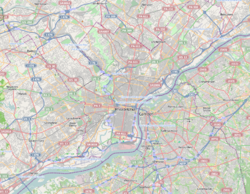Fort Mifflin
|
Fort Mifflin
|
|

A painting of Fort Mifflin by Seth Eastman commissioned by the US Army in 1870
|
|
| Location | Fort Mifflin Road Philadelphia, Pennsylvania |
|---|---|
| Architect |
John Montresor Pierre Charles L'Enfant Louis de Tousard |
| NRHP Reference # | 70000554 |
| Significant dates | |
| Added to NRHP | August 29, 1970 |
| Designated PHMC | May 10, 1990 |
Coordinates: 39°52′31″N 75°12′47″W / 39.8753°N 75.213°W
Fort Mifflin, originally called Fort Island Battery and also known as Mud Island Fort, was commissioned in 1771 and sits on Mud Island (or Deep Water Island) on the Delaware River below Philadelphia, Pennsylvania near Philadelphia International Airport. During the American Revolutionary War, the British Army bombarded and captured the fort as part of their conquest of Philadelphia in autumn 1777. The United States Army began to rebuild the fort in 1794 and continued to garrison and build on the site through the 19th century. It housed prisoners during the American Civil War. The army decommissioned Fort Mifflin for active duty infantry and artillery in 1962 however while the older portion of the fort was returned it to the City of Philadelphia; a portion of the fort's grounds are still actively used by the United States Army Corp of Engineers making it the longest fort in military use in the United States. Historic preservationists have restored the fort.
Upon foundation of Philadelphia in 1681, people recognized Mud Island near the confluence of the Delaware River and Schuylkill River as strategically important for the defense of the settlement.William Penn, a Quaker with religious objections to military life, however, left Philadelphia undefended. Whenever European colonists established permanent settlements, fortifications in or near those settlements commonly provided protection. Quakers founded the only significant European settlements without fortification. As the Quakers rejected the military, they sought to make peace with the Native Americans in the area to avoid the need for fortifications. While other colonies suffered from conflict and warfare, Philadelphia prospered.
...
Wikipedia



